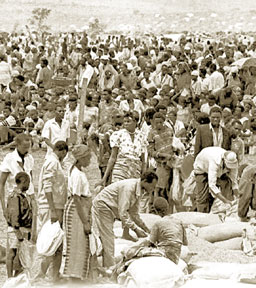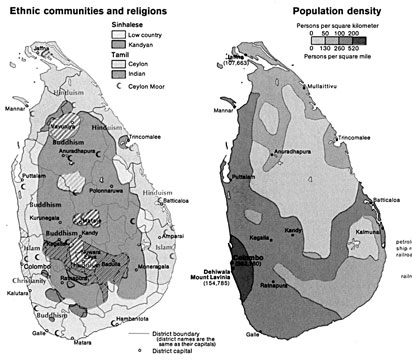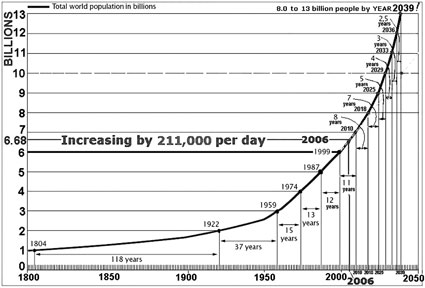|
Today is World Population Day:
 |
|
Prof. S. T. Hettige |
Everyone counts
by Indunil THENUWARA
Every hour, every minute, every second, hundreds of babies are born
somewhere around the world. The global population grows by leaps and
bounds and the population explosion is a reality for the whole world
except in a few countries which report negative population growth.
But the resources required for this massive population are not
increasing; in fact, they are dwindling. Thus, the population explosion
and the resultant sharing of limited resources among a larger number of
people have posed many problems such as poverty, hunger and even wars.
This places an increasing burden on Planet Earth with threats to the
ecosystem, atmospheric carbon dioxide, global warming and pollution
becoming more real and immediate.
That is why, as the World Population Day, spearheaded by the United
Nations Population Fund (UNFPA), is celebrated on July 11 (today) it is
important to discuss and decide on population issues. They are so severe
that the issue has been compared to a ticking time bomb. It’s assumed
that humans will soon run out of the resources that are needed to
sustain themselves.
According to Senior Professor of Sociology of the University of
Colombo, S. T. Hettige, Sri Lanka’s population is no longer rising and
has now more or less stabilised.
 This fact has been confirmed by the Census and Statistics Department
as well. Accordingly, Sri Lanka’s birth and death rates remained high
until the mid-40s. From the 40s to the early 60s, falling death and
almost stable birth rates were noted while a steady decline in fertility
was witnessed around the 60s, narrowing the gap between birth and death
rates. This fact has been confirmed by the Census and Statistics Department
as well. Accordingly, Sri Lanka’s birth and death rates remained high
until the mid-40s. From the 40s to the early 60s, falling death and
almost stable birth rates were noted while a steady decline in fertility
was witnessed around the 60s, narrowing the gap between birth and death
rates.
The last census conducted in Sri Lanka in 2001 put the local
population around 19 million. However, the population as at 2009 stood
at 20,450,000 and is expected to reach 21.5 million in 2015.
A more pressing issue in the island, according to Prof. Hettige, is
the temporary migration of Sri Lankans, in search of lucrative
employment opportunities, to other parts of the world. Currently, around
2.5 million Sri Lankans are residing outside their country of birth.
This exodus has had an impact on labour, he said, with the population
at a stable point and the working population migrating from the country.
Sectors such as agriculture and industry have faced the consequences,
with wages going up and Sri Lanka losing its competitive edge in the
international market.
“We had a competitive edge over countries in the region during the
1976/77 era, but now, we are less competitive and less productive than
India, China, Bangladesh or Nepal,” the Professor said.
He said: “It’s good that our population has stabilised, considering
that Sri Lanka has one of the highest population densities in the
region. As a result of increased population, the pressure on land,
housing and other resources has increased by leaps and bounds.
Increasing examples of the human-elephant conflict are just one of the
results of these developments.”
 Another concern, according to him, is the ageing population in the
country. “The proportion of over-60s stand at around 11 percent at the
moment and would increase in future. Another concern, according to him, is the ageing population in the
country. “The proportion of over-60s stand at around 11 percent at the
moment and would increase in future.
However, this need not be a big issue as most of them will continue
to be active, with a prolonged working life, and looking after them
won’t necessarily be the responsibility of the State. The ageing
population may be a panic inducing situation only in countries with a
universal social security system, but this is not the case in Sri Lanka.
“Here, most elderly people continue to work. Even those who are not,
are looked after by their families or charities. They are not a burden
to society or to the State and this situation is not likely to change
much in the future”.
However, Prof. Hettige stressed the need for more investments in the
area of social infrastructure.
“First of all, the ageing population would need direct cash transfers
such as pension, EPF etc. Then there is a need for social infrastructure
such as a good public transport system, food security, health sector, a
proper garbage disposal system, cleaner environment and leisure
facilities.
Such systems are in place in all developing countries and also most
countries in the South East Asian region. The Government has to focus on
them as a priority area to cater to the vulnerable and physically weak
segments of our population. There is also a need to strengthen our
family network, to support children, the elderly, sick and disabled.”
Prof. Hettige emphasised that economic development has to incorporate
human resource development as well as technological advancements for
such development to be really effective and meaningful to the
population.
 World Population Day was inaugurated by the UNFPA in 1988 to mark
July 11, 1987, when the global population reached five billion. The day
focuses attention on the urgency and importance of population issues,
particularly in the context of overall development plans and programs
and the need to find solutions to these issues. World Population Day was inaugurated by the UNFPA in 1988 to mark
July 11, 1987, when the global population reached five billion. The day
focuses attention on the urgency and importance of population issues,
particularly in the context of overall development plans and programs
and the need to find solutions to these issues.
The UNFPA is a development agency which deals with population issues
and promotes the right of every man, woman and child to enjoy a life of
health and equal opportunity. It extends its support to countries to use
their population data for policies and programs to reduce poverty and
improve the livelihoods of their people. The agency decides the annual
theme for the event.
This year’s theme is ‘Everyone Counts’ and highlights the importance
of data for development. It will focus on how reliable data makes a
difference with the key being to collect, analyse and disseminate data
in such a way that results in good decision-making.
The growing population - global figures
According to statistics released by the US
Census Bureau, the global population stood at 6,825,300,000 as of June
5, 2010, having surpassed the 6.8 billion mark in 2009. Between
2040-2050, the population is expected to reach a figure of nine billion.
The fastest population growth rate was
reported in the 50s, at 1.8 percent per year, reaching a peak of 2.2
percent in 1963. However, this growth rate has halved to 1.1 percent by
2009 with the Middle East and Sub-Saharan Africa being exceptions.
The world saw annual births numbering 134
million, which reached a peak of 163 million in the late 90s. It's
expected to remain at a constant for a while. According to the US
Central Intelligence Agency's World Factbook for 2007, the world
population increased by 211,090 every day. Meanwhile, the number of
deaths per year stand around 57 million and is expected to grow to about
90 million by 2050.
Asia is home to about 60 percent of this
global population (3.8 billion) with China and India contributing to 40
percent between themselves. It's followed by Africa with 840 million (12
percent), Europe 716 million (11 percent), North America 514 million
(eight percent), South America 371 million (5.3 percent) and Australia
21 million (0.3 percent).
|

